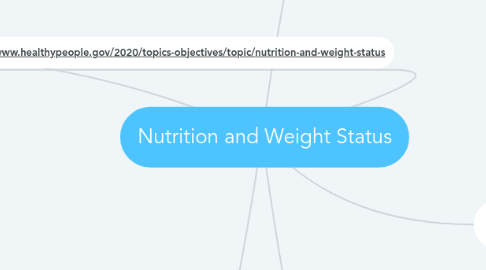
1. QSEN Competencies
1.1. Patient-Centered Care
1.1.1. Educate patients on dietary needs
1.1.1.1. Dependent on diseases present
1.1.1.2. Dietary consult
1.1.1.3. Healthy living tips
1.2. Teamwork and Collaboration
1.2.1. Food and nutrition services
1.2.2. Dietician
1.2.3. PT & OT
1.3. Evidence-Based Practice
1.3.1. Age and weight status impact on food decisions
1.3.2. Healthy weight and lowering disease risks
1.4. Quality Improvement
1.4.1. Identify possible solutions on how to increase access to nutritional foods in individuals with low SES
1.4.2. Increase the number of individuals in a population subset that can identify the key components of a healthy diet
1.5. Patient Safety
1.5.1. Losing weight to improve health status
1.6. Informatics
1.6.1. Educational pamphlets
1.6.2. Logging diet and weight data
2. Objectives
2.1. By the end of this course, students will be able to describe the relationship between nutrition and weight status through a powerpoint presentation. (Affective Domain, Valuing Level)
2.2. By the end of the course, students will be able to identify three factors that affect weight status. (Cognitive Domain, Remembering Level)
2.3. By the end of the course, students will be able to identify how nutrition affects overall health, by identifying 5 different disease processes that are affected by nutrition. (Cognitive Domain, Evaluating Level)
3. https://www.healthypeople.gov/2020/topics-objectives/topic/nutrition-and-weight-status
4. AACN Essentials
4.1. Essential I: Liberal Education for Baccalaureate Generalist Nursing Practice
4.1.1. Pathophysiology
4.1.1.1. Impact of nutrition on different disease states
4.1.2. Diet Therapy
4.1.2.1. Education on different types of diets
4.1.3. Health Psychology
4.1.3.1. How the mind works
4.1.3.2. How to motivate people to lose weight in an effective and lasting way
4.2. Essential II: Basic Organizational and Systems Leadership for Quality Care and Patient Safety
4.2.1. Understand the relationship between nutrition and quality health care
4.2.1.1. Ex: nutrition and wound healing
4.2.1.2. Ex: nutritional needs for chemotherapy patients
4.3. Essential III: Scholarship for Evidence Based Practice
4.3.1. Identify scholarly sources
4.4. Essential IV: Information Management and Application of Patient Care Technology
4.4.1. Nutritional logs
4.5. Essential V: Health Care Policy, Finance, and Regulatory Environments
4.5.1. Financial burden of overweight and obese individuals on healthcare systems
4.6. Essential VI: Interprofessional Communication and Collaboration for Improving Patient Health Outcomes
4.6.1. Dietary
4.6.2. Food services
4.7. Essential VII: Clinical Prevention and Population Health
4.7.1. Health promotion through active lifestyle
4.7.2. Disease prevention through proper nutrition
4.8. Essential VIII: Professionalism and Professional Values
4.8.1. Protecting human dignity and respect when educating patients on nutrition and confronting weight status
4.9. Essential IX: Baccalaureate Generalist Nursing Practice
4.9.1. Develop plan of care for individual patients
5. NCSBN
5.1. Safe and Effective Care Environment
5.1.1. Management of care
5.1.1.1. Communicating with physician and dietician about patient's needs
5.1.2. Safety and infection control
5.1.2.1. Following proper guidelines when administering IV or tube feedings
5.2. Health Promotion and Maintenance
5.2.1. Patient education
5.3. Psychosocial Integrity
5.3.1. Psychological impact of being overweight
5.3.2. Recognizing factors that lead to poor nutrition and weight status
5.4. Physiological Integrity
5.4.1. Identify patient's nutritional needs and interventions needed to meet those needs

